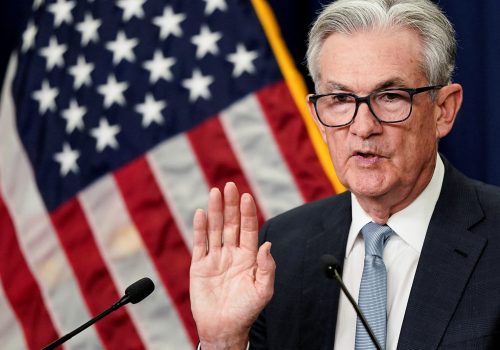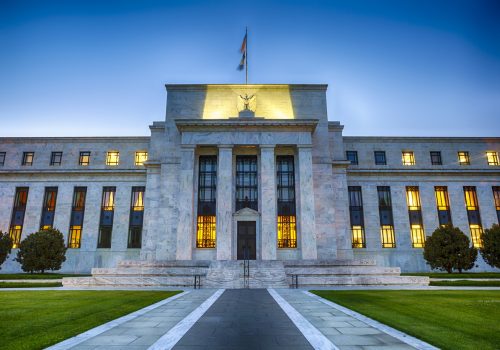The Fed has regained the initiative, but at a cost
The Federal Open Market Committee (FOMC) raised the Fed funds target rates by 75 basis points to 1.50%-1.75% on June 15 2022. Fed Chairman Jerome Powell said in the following press conference that another hike of 50 or 75 basis points in the July FOMC meeting is the most likely outcome. The Fed also reaffirmed its quantitative tightening by redeeming US Treasury securities in its holdings up to a cap of $30 billion a month, and agency debt and mortgage-backed securities up to a cap of $17.5 billion a month. FOMC members expect to finish their tightening regime with the Fed funds rate around 3.75% by the end of 2023. Financial markets reacted positively to the Fed’s resolute actions, with the S&P 500 stock market index rallying by 1.46%. However, that rally was reversed the next day amid sharp declines in equity markets around the world.
The Fed’s aggressive policy stance will also bring significant economic costs. The FOMC revised its estimate for 2022 GDP growth downward to 1.7% from 2.8% in its March forecasts, and the unemployment rate upward to 4.1% by 2024, from today’s 3.6% rate. Still, the Fed also expects inflation to trend down towards 2% by then from 8.6% in May. Such an outcome is considered by Chairman Powell to be consistent with his expectation of a “soft or softish landing” from the current bout of 40-year high inflation.
However, whatever the Fed may have hoped to gain by acting forcefully to push back market perception of it being “behind the curve”, it has raised serious concerns about tipping the economy into a recession. This will be the case if the US experiences another GDP contraction in the second quarter following the 1.5% decline in the first quarter. Tellingly, the Atlanta Fed GDPNow model has just estimated a flat second quarter, putting the US economy on the brink of a recession.
As ever, the Fed’s actions will have ramifications around the world. First and foremost, they will put pressure on the European Central Bank (ECB) to tighten at their next meeting in July in the face of record-high inflation of 8.1% in May in the Euro area. However, the ECB’s task has been complicated by the need to address widening sovereign bond yield spreads of peripheral highly-indebted members like Italy and Greece, versus the preeminent core country, Germany. In a rare emergency meeting on June 15, the ECB promised to use its current bond purchase program flexibly by tilting the reinvestment of maturing debt toward weaker members to prevent bond yield spreads from getting out of hand. It will be launching an “anti-fragmentation instrument” soon to help reduce tension within the European monetary system.
However, in contrast to the 2010 Euro area sovereign debt crisis, inflation now gets in the way. A bond-buying program will now be at odds with the need to tighten monetary policy to bring inflation back under control. Raising the floor for rates while attempting to lower long-term bond yields in peripheral countries is inherently contradictory and may end up compromising the efficacy of both operations. This could leave the Euro area vulnerable to stubbornly high inflation and widening spreads of peripheral sovereign bonds. This is an unsettling prospect given the high level of uncertainty caused by the war in Ukraine.
The Bank of England has raised its policy rate the fifth time by only 25 basis points, but said that it would “act forcefully” if needed to prevent persistent high inflation. The Swiss National Bank has also increased its policy rate by 50 basis points for the first time in 15 years.
For some countries where inflation remains moderate, the Fed’s actions have constrained the ability of central banks to support their slowing economies. In particular, the to ease monetary policy much to support stalling growth for fear of further weakening the RMB against the USD. China has just begun to recover from the slowdown triggered by the debt crisis of property developers and a series of lockdowns in Shanghai and parts of Beijing due to Covid-19 infection waves. However, these risks are still very much present and could return to slow growth again before too long.
The Fed’s actions will intensify headwinds already affecting most emerging markets and developing countries. Weaker growth in the US and China will reduce demand from two key markets for their commodity exports. Higher US interest rates and a stronger USD have triggered net capital outflows from emerging markets, tightening financing conditions. The war in Ukraine continues to raise energy and food prices amid severe food shortages in poor countries. Many developing and low-income countries with high levels of debt and debt-servicing burdens will be pushed into economic and debt crises in the foreseeable future.
In short, the Fed may well have been right in taking forceful actions now to fight inflation after failing to control it, but such actions add to the challenges experienced by economies around the world.
Hung Tran is a nonresident senior fellow at the Atlantic Council, former executive managing director at the International Institute of Finance and former deputy director at the International Monetary Fund.

At the intersection of economics, finance, and foreign policy, the GeoEconomics Center is a translation hub with the goal of helping shape a better global economic future.
Related reading
Image: Facade on the Federal Reserve Building in Washington DC


